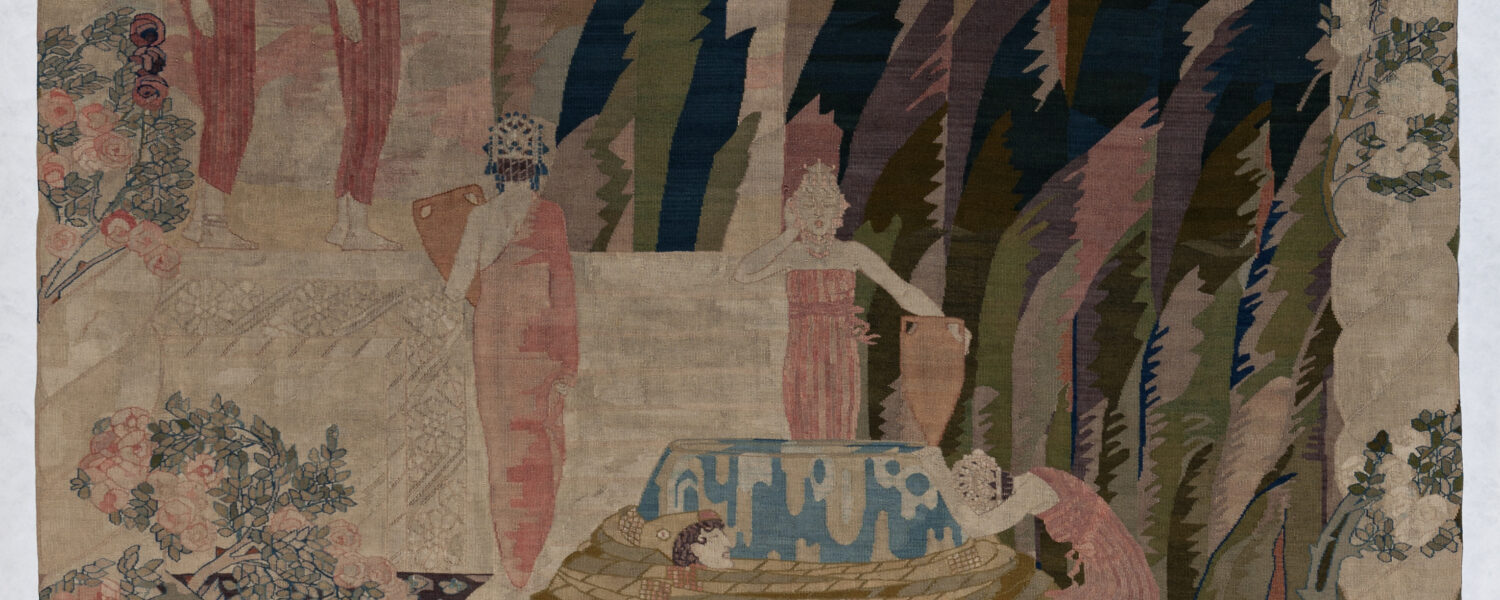Frida Hansen
An international Art Nouveau artist from Stavanger
Frida Hansen (1855−1931), one of Norway’s foremost textile artists of all times, had a significant international career. Her interest in weaving was related to a revitalization of the Norwegian weaving tradition. Like many of her contemporaries, she was strongly inspired by older Norwegian wall weavings (åklær). She learned to use the old vertical loom technique and travelled around Jæren and Ryfylke to learn from farm women how to organically dye yarn. Along with mastering this local knowledge, Hansen was well-oriented in the main artistic impulses from Europe, not least Art Nouveau style.
The tapestries in this room are in Stavanger Art Museum’s collection, either as deposits or purchases. The works stem from various periods in Hansen’s career, with the impressive Semper Vadentes from 1905 as a high point. This tapestry depicts four women walking through an open landscape and carrying each their own attribute. It has been interpreted as describing different paths in life, also as relating to a landscape Hansen knew well. In 1930, when she was interviewed by the newspaper Stavanger Aftenblad, she said: ‘The four women who walk through life on my “Semper Vadentes”, I’ve sketched with Jæren in the background; far in the distance we see the sea towards which they walk.’ Along the tapestry’s lower edge is the text ‘Semper Vadentes. Semper Agentes. Semper e natu in vitam ad aeternum. Domine’. This could be translated as ‘Always moving. Always acting. Out of the cradle, into life, into eternity. O Lord.’
Another central tapestry is The Danaides’ Barrel, from 1914. For this work, Frida Hansen chose a subject from Greek mythology. Woven into the tapestry are the words Poena Danaidum, which refers to the punishment the 50 daughters of Danaus received after they killed their husbands on their wedding night: according to one version of the myth, they were condemned for all eternity to fill a bottomless vessel with water. The imagery shows how Hansen allowed herself to be influenced by current trends in pictorial art. The tall cypresses bring to mind the Swiss artist Arnold Böcklin’s (1827–1901) painting Die Toteninsel (Isle of the Dead) from 1880, which was very popular in the early 1900s. The stylised waves at the bottom of the tapestry show how Hansen, like many artists at the time, drew inspiration from Japanese woodblock prints.
One of Hansen’s greatest contributions to international weaving is the technique she invented for creating transparent passages in portieres (doorway curtains) – she herself called these works ‘transparents’. The translucent effect is achieved by using wool yarn for both the warp and weft. Because wool fibres cling to each other, this makes it possible to leave open fields in the weft such that light can shine through.
One of the doorway curtains is entitled Mermaids, a theme she also used for the tapestry Mermaids Lighting the Moon. These mysterious female beings who represent an imagined link between humans and nature were a popular theme during the Art Nouveau period. So also flowers, which enjoy a dominant position in her woven art. Hansen was herself an enthusiastic gardener in her younger years, and in her works we find several identifiable species.
